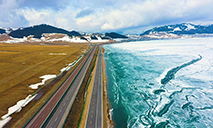China science, technology news summary -- May 8
BEIJING, May 8 (Xinhua) -- The following is a summary of published science and technology news of China.
WIND FORECAST SYSTEM
China has for the first time realized the fine forecast of Earth's near-surface wind for a major space launch mission, according to the Xichang Satellite Launch Center.
The fine forecast system for wind in key areas of the near-surface layer has been applied to ensure the transfer of the combination of the Tianzhou-4 cargo spacecraft and the Long March-7 Y5 carrier rocket to the launching area of the Wenchang Spacecraft Launch Site, the center said.
The system was developed by the meteorological tech support team of the center to overcome challenges from the Earth's near-surface wind, which has a great impact on the smooth vertical transfer of spacecraft and rockets.
LOW-CARBON DEVELOPMENT
China is looking to highlight the green and low-carbon development philosophy in school education to increase public awareness in this regard.
According to a work plan released by the country's Ministry of Education, educational institutions are to integrate the development philosophy in their curricula and hold relevant educational activities extensively.
The work plan also emphasized the need to establish and develop college majors related to low-carbon and green development, such as energy storage and hydrogen energy.
CARBON EMISSIONS AND BIODIVERSITY
How might global warming put our planet in jeopardy in the near future? A research group examined the situation 300 million years ago and revealed a scenario with a significant drop in biodiversity.
A recent study published in the Proceedings of the National Academy of Sciences showed that abrupt warming linked to massive carbon emission 304 million years ago caused an anoxic area extent equivalent to about 20 percent of the seafloor.
Scientists from China, the United States and New Zealand collected samples in southwest China's Guizhou Province and measured carbon and uranium isotopes within the samples to explore global carbon cycling and marine anoxia.
Photos
Related Stories
Copyright © 2022 People's Daily Online. All Rights Reserved.










